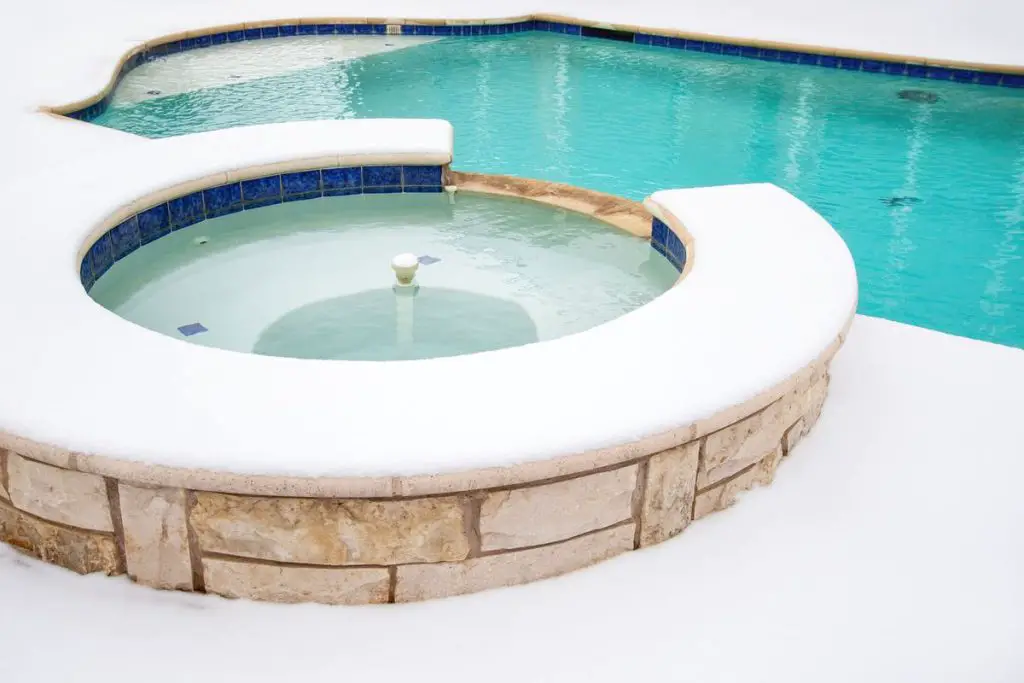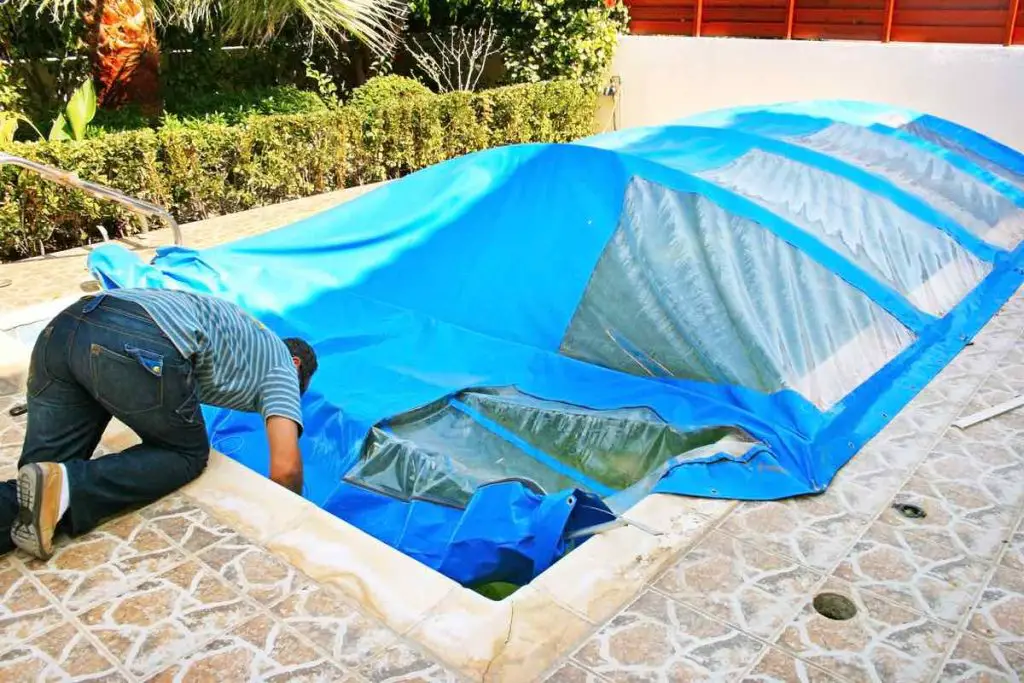As the temperatures drop, it’s time to start thinking about winterizing your pool. But how much shock do you need to add to your pool water to winterize it ensure it’s adequately protected from the cold weather?
You need at least 2 lbs (0.9 kg) of shock per 10,000 gallons (38 cubic meters) of water to shock and winterize your pool correctly. This will ensure that your pool is properly sanitized and protected from the cold weather. Follow the package instructions for how to mix and apply the shock properly.
This detailed guide will explore in-depth everything you need to know about how much shock you need to winterize your pool, including why it’s necessary, types of pool shock, and how to shock your pool properly. Buckle up, and let’s dive in!

Why You Need To Shock Your Pool Before Winterizing It
Since you will be closing your pool for the winter, bacteria, algae, and other contaminants can start to grow in the water. When left unchecked, these contaminants can damage your pool and make it unsafe to swim in come springtime.
Shocking your pool before winterizing it will kill bacteria, algae, and other contaminants lurking in the water. A pool shock oxidizes chloramines and other contaminants in the water, which helps to keep your pool clean and clear. The high chlorine levels also deter algae growth and other contaminants from taking hold in the water.
Lastly, it can help to reduce the costs of de-winterizing your pool.
Types of Swimming Pool Shock
While shocking means raising the chlorine levels in your pool water, you can’t shock with regular chlorine tablets. You need to use a pool shock designed specifically for shocking pools. There are three main types of pool shocks:
- Liquid chlorine
- Calcium Hypochlorite (Cal-Hypo)
- Trichlor
Liquid Chlorine
Liquid chlorine is the most common type of pool shock. It is fast-acting, easy to use, and effective at killing bacteria and algae. Liquid chlorine is a strong oxidizer, so it will quickly raise the chlorine levels in your pool water.
Unfortunately, it has a high pH, which can make your pool water more alkaline. You may need to use more muriatic acid to stabilize the pH to the recommended 7.2 to 7.8 range.
For more information on pool chemicals, check out The Beginner’s Guide to Pool Water Chemistry.
Calcium Hypochlorite (Cal-Hypo)
Calcium hypochlorite is a granular, fast-acting pool shock. It is effective at killing bacteria and algae, but it can be harder to dissolve in pool water. You may need to pre-dissolve the calcium hypochlorite in a bucket of water before adding it to your pool.
Cal-Hypo also raises the calcium levels in your pool water by 0.8 ppm, which can help to prevent scaling and staining. Like liquid chlorine, it has a high pH, so you may need to use more muriatic acid to stabilize the pH of your pool water. Use it after dusk when you’re running the filter pump.
Trichlor
Trichlor is a granular, slow-acting pool shock. It is highly effective at killing algae but takes longer to dissolve in pool water. You may need to run your filter pump for 12 to 24 hours after adding trichlor to your pool to ensure it is properly dissolved. One downside is that trichlor has a very low pH (around 3), so you may need to increase the pH of your pool water after adding it.
How To Shock Your Pool Before Winterizing
Proper pool shocking is key to keeping your pool clean and safe to swim in next spring. And while it might seem a daunting task, it’s quite simple. Just follow these easy steps:
Test, Don’t Guess
The first step is to test your pool water to see what kind of shape it’s in. Test the pH, alkalinity, and chlorine levels. You can use a pool test kit or strips to do this. Adding too much or too little shock can damage your pool, so getting the levels right is important. Ensure your pool water ticks the following:
- pH level of 7.2 to 7.8. When the pH is too high, it will make the pool water more alkaline and increase the risk of scaling and staining. If it is too low, it will make the pool water more acidic and increase the risk of corrosion.
- Alkalinity level of 80 to 120 ppm. Maintain the ideal alkalinity level to help buffer the pH and prevent it from changing too rapidly.
- Chlorine levels of 1 to 3 ppm. You need a minimum chlorine concentration of 1 ppm to kill bacteria and algae effectively. But you don’t want to go overboard, as too much chlorine can irritate swimmers’ skin and eyes.
If any of these levels are off, you’ll need to adjust them before shocking your pool. For example, if the pH is too high, you’ll need to lower it by adding muriatic acid. If the chlorine levels are too low, you can raise them by adding chlorine tablets or granules.
Calculate How Much Shock You Need to Winterize
The next step is to calculate how much shock you need to winterize your pool properly. The amount you’ll need depends on the size of your pool, current pH and alkalinity levels, and the desired chlorine levels.
The standard shock dose is 2 lbs. (0.9 kg) of shock per 10,000 gallons (38 cubic meters) of pool water. If you’re using liquid chlorine, this translates to 10 ounces (296 ml) per 10,000 gallons (38 cubic meters) of pool water. But this is a general guideline, and you may need to adjust the dose depending on the condition of your pool water.
For example, if your pool has a lot of algae or is very dirty, you’ll need to use a higher dose of shock. However, if your pool is clean and well-maintained, you can use a lower dose to winterize it.
Add the Shock to Your Pool
Now that you know how much shock you need, it’s time to add it to your pool. The best way to do this is to pour the shock around the pool’s edge. Avoid adding it directly to the skimmer, as this can damage the filter.
If you’re using a granular pool shock, dissolve it in a bucket of water before adding it to the pool. This will help prevent the shock from clumping together and falling to the bottom of the pool. ADD shock to water and NOT water to shock unless instructed so by the manufacturer.
Let the Pool Circulate
After adding the shock, it’s important to let the pool circulate for at least 24 hours. This will help distribute the chlorine evenly throughout the pool. You can run the pool filter or use a pool brush to help circulate the water.
Test the Pool Water Again
After 24 hours, test the pool water again to ensure the chlorine levels are where they need to be. The ideal chlorine level after shocking is 3 to 5 ppm. If the levels are still too low, you can add more shock.
Once the chlorine levels are where they need to be, you can winterize your pool.

Final Thoughts
Pool shocking is a critical step in winterizing your pool. You need 2 lbs (0.9 kg) of pool shock per 10,000 gallons (38 cubic meters) of pool water to kill bacteria and algae effectively. But the amount you’ll need may vary depending on the condition of your pool water.
Be sure to test your pool water before and after shocking to ensure you’re adding the right amount. And always let the pool circulate for at least 24 hours after adding the shock.
